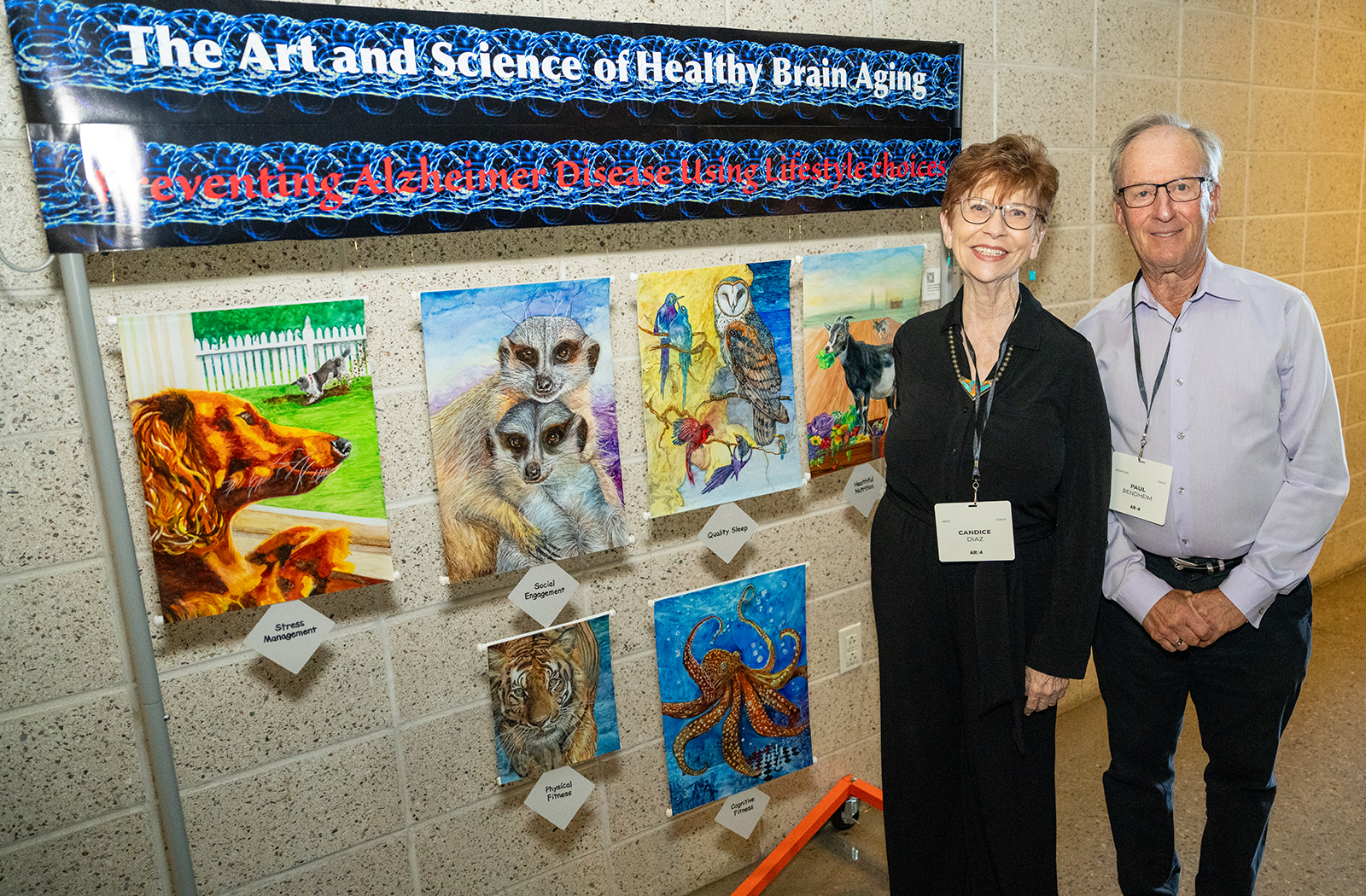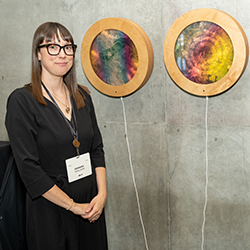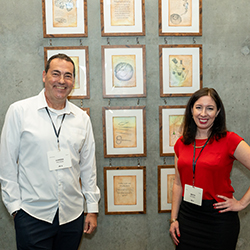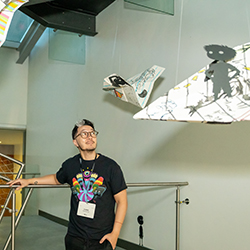
Research Discoveries Take on New Forms through the Arts

The University of Arizona College of Medicine – Phoenix and the Phoenix Bioscience Core (PBC) have always been a big proponent of the arts. Their ability to inspire creativity, problem solving, communication and empathy are crucial to the work and learning done by medical students, faculty, staff and researchers.
Cindy Ivy, OTD, a clinical professor of Occupational Therapy with Northern Arizona University, chairs the PBC Arts Committee. For her, bridging the two is essential for those who work in health care. “I have always held a strong interest in the Art and Medicine program because the blending of art and science is something I am passionate about; I believe in this concept for so many reasons, not the least of which is that art is healing,” she said.
As part of that focus, the PBC pairs local artists with researchers from across Phoenix’s health science community to communicate their work through unique pieces of art. Over the course of nine months, they meet and collaborate, culminating in a project that is infused with the spirit of each researcher’s discipline.
On Friday, September 19, those collaborations were unveiled at a reception celebrating the 4th Annual Artists + Researchers exhibit in the Health Sciences Education Building (HSEB). A few of the artists and researchers shared their perspectives on the project and how their exhibits visualize their work.
In the Wake
Brittany Krzyzanowski, PhD, an assistant professor of Parkinson’s disease research at Barrow Neurological Institute, was paired with Kendra Sollars, a Tempe-based artist whose work aims to navigate the delicate intersection between humanity and the natural world. Dr. Krzyzanowski uses data from more than 22 million patients across the U.S. to investigate how exposure to toxins in the environment may have impacted their risk of developing Parkinson’s disease.

Their exhibit — titled In the Wake — blended real-life studies conducted by Dr. Krzyzanowski into a dazzling display of maps, movement and coded LEDs to show how certain environmental contaminants can travel through air, water and soil. “The maps in this work are not imagined landscapes. They are real locations where contamination has been documented and studied,” Dr. Krzyzanowski explained. The contaminations discovered in Montague, Michigan’s White Lake, Walpole, Massachusetts, and Williston Basin near Williston, North Dakota, “Carry the long shadow of these invisible exposures,” she added.
“In the Wake is not only a record of what already happened, but a call to action for the future. In each of these cases, toxins were allowed to spread unregulated. We hope this piece spreads awareness of the dangers of these toxins and inspires others to take action,” Sollars said.
For Dr. Krzyzanowski, Sollars artistic merging of digital video projection and tech-based media was a welcome change from the traditional journal publication. “I rarely get the chance to reflect on how to best convey my work to the general public,” she said. “Using art to communicate our studies to the public enabled us to demonstrate concepts with more flexibility.”
Decoded
Aaron McGee, PhD, a professor in the Department of Translational Neurosciences, collaborated with Beth Eckel, a Phoenix-based artist whose work explores the human experience through anatomical precision and emotional depth.

Eckel, who was trained in classical realism at the Barcelona Academy of Art, used the expertise of Dr. McGee to craft 12 drawings — Decoded. Her hope: to replicate the feel of a scientist’s notebook. “There’s nothing more intimate or telling about a scientist than looking through their research notes. It’s the same with artists and our sketchbooks,” Eckel said. “They show our process, our rough ideas, our development. It’s the closest glimpse you can get into our minds.”
To help realize Dr. McGee’s work, Eckel visited his lab to see what he does firsthand. “Artists don’t usually get the opportunity to witness groundbreaking research happening right in front of them, and that was so exciting,” she said.
She was also appreciative of his passion, an enthusiasm that really piqued her interest in the possibilities of the project.
The Stories We Carry
Manisha Thakkar, MD, a clinical assistant professor and educator in the college’s Doctoring course, partnered with Chris Ignacio, a Filipino American puppeteer, producer, educator and interdisciplinary artist whose work explores the intersection of voice, technology and identity.

Their collaboration — The Stories We Carry — was a series giant paper airplanes piloted by solitary shadow puppet figures. Crafted entirely from paper, the display hung from the underside of the stairs in the HSEB. “Its surface is layered with primarily abstract symbols alongside more familiar ones, drawn from the personal narrative of a single child,” Ignacio said.
The symbols, resembling ink blots, bug trails or calligraphy, were generated using an audio visualization technique that translated the participant’s spoken story into graphic forms. The intent: To, “form a visual asemic language — suggesting meaning through abstract marks, rather than literal text — acting as both a record and a metaphor for a life story,” he said.
“The paper airplane recalls the playful act of folding and throwing notes across a classroom, an early form of storytelling and connection. In this context, it becomes a symbol of how we share our narratives with others,” Ignacio added.
“The goal of this project is to portray the joy of connection, belonging with nostalgic childhood memories and embracing our imperfections with the art of healing,” Dr. Thakkar said. “It's about making complex medical concepts accessible and creating the moments that make a person feel alive and uplifted.”
2025 Cohort
- Grounds for Recovery – Patricia Sannit, and Christopher Wharton, PhD, professor, Arizona State University (ASU) College of Health Solutions.
- In the Wake – Kendra Sollars and Dr. Krzyzanowski.
- The Stories We Carry – Chris Ignacio and Dr. Thakkar.
- Beckoned Upward by the Wallpaper as I Drifted into a Cold Bed – Kris Manzanares and Oaklee Rogers, PhD, associate dean for the College of Health Sciences, Boise State University.
- Untitled – Marshall Shore and Jean Robey, MD, assistant clinical professor in the college’s Division of Nephrology.
- Using Health Data for Better Health Outcomes – Cyd Peroni and Tim Lant, director of program development, ASU’s Knowledge Enterprise.
- Iterative Growth – Hannah Deni Schlossmacher and Candice Wike, PhD, associate director of Emerging Technologies, Translational Genomics Research Institute.
- The Art and Science of Health Brain Aging – Candice Diaz and Paul Bendheim, MD, clinical professor in the college’s Department of Neurology.
- Decoded – Beth Eckel and Dr. McGee.
An official launch of the exhibits will take place on Friday, November 7, at the Arizona Science Center. Tickets are available now.
About the College
Founded in 2007, the University of Arizona College of Medicine – Phoenix inspires and trains exemplary physicians, scientists and leaders to advance its core missions in education, research, clinical care and service to communities across Arizona. The college’s strength lies in our collaborations and partnerships with clinical affiliates, community organizations and industry sponsors. With our primary affiliate, Banner Health, we are recognized as the premier academic medical center in Phoenix. As an anchor institution of the Phoenix Bioscience Core, the college is home to signature research programs in neurosciences, cardiopulmonary diseases, immunology, informatics and metabolism. These focus areas uniquely position us to drive biomedical research and bolster economic development in the region.
As an urban institution with strong roots in rural and tribal health, the college has graduated more than 1,000 physicians and matriculates 130 students each year. Greater than 60% of matriculating students are from Arizona and many continue training at our GME sponsored residency programs, ultimately pursuing local academic and community-based opportunities. While our traditional four-year program continues to thrive, we will launch our recently approved accelerated three-year medical student curriculum with exclusive focus on primary care. This program is designed to further enhance workforce retention needs across Arizona.
The college has embarked on our strategic plan for 2025 to 2030. Learn more.